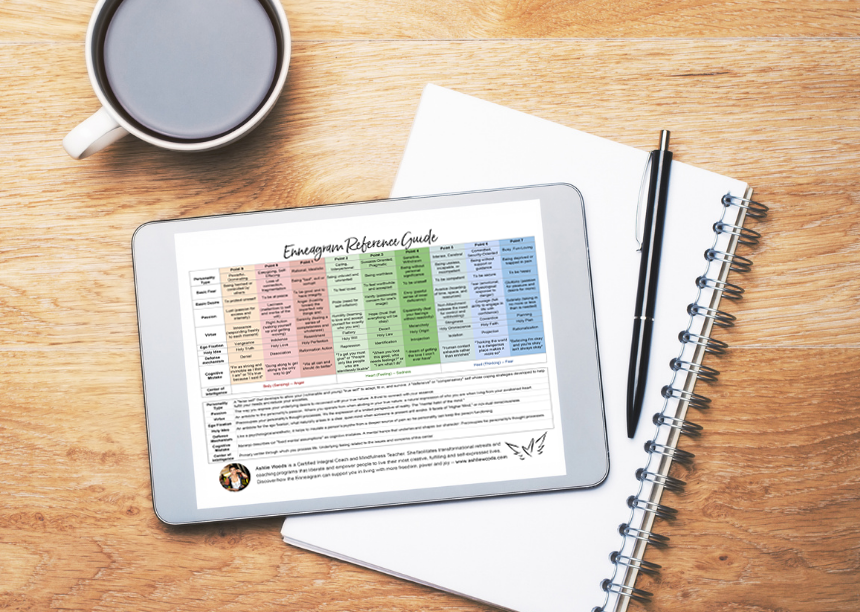Self-Preservation One — "Worry"
For the Self-Preservation One, anger is most repressed. To render their own anger less threatening, the mechanism of reaction formation transforms the heat of anger into warmth. And this is a major shift-an angry person disconnecting from his anger to become a gentle, supportive person with good intentions. In this subtype, the anger of the One, together with defenses against that anger, manifest as good intentions, perfectionism, heroic efforts, obedience to rules, and an obsessive striving for perfection.
The outward result is an excessively gentle, decent, and kind person. In the quest to perfect themselves, Self-Preservation Ones believe it’s bad to be angry and so make a virtue of being tolerant, forgiving, and sweet whenever possible. Underneath, these Ones are very angry, but they control it. Under pressure, however, this One’s anger may leak out as irritation, resentment, frustration, or self-righteousness.
This quick reference guide captures the various aspects of each Enneagram Type including attributes, basic fears, desires, passions, virtues, fixations, defense mechanisms, and more!
The Self-Preservation One worries a lot. This subtype has a need for foresight, a desire to plan everything out, and a compulsion to try to have everything under control. Self-Preservation Ones often had a chaotic family history where they had to provide the stability, even as young children. These Ones were usually the most responsible person in the family. Perhaps because their survival felt threatened by out-of-control elements in their early environment, this subtype has a lot of anxiety. They lack confidence that things will go as they should, so they display an excessive sense of responsibility that takes the form of worrying and fussing, even when things are going well.
This One has an ongoing sense that anything could go wrong at any minute unless they are on high alert to make sure that things happen as they should. This One also has a faulty sense of security with regard to survival and an implicit anxiety about things not going well and the consequences of failure. Self-Preservation Ones can sometimes let go of worrying if they become convinced there is nothing they can do about a situation, but it is difficult for them to stop being vigilant if there is something they can do to have an effect on the situation.
This tendency toward feeling anxious and constantly on guard can, in some cases, trigger obsessive-compulsive defenses; that is, Self-Preservation Ones can become obsessive in their thinking and compulsive or ritualistic in their behaviors as they attempt to reduce anxiety by thinking certain thoughts or engaging in certain behaviors. The Self-Preservation One does so to gain a sense of control over what is happening, and through gaining a sense of control, finally be able to relax. However, there are so many things to be done and worried about that this One is rarely able to relax.
This subtype is the epitome of a true perfectionist, as they are especially hard on themselves if they don’t get things right. As Naranjo points out, Self-Preservation Ones have difficulty loosening their need for control and allowing for a flow to happen. Instead they feel compelled to insert themselves if necessary, to make sure every important detail gets scrutinized and perfected. The quest to do the right thing or to find the perfect solution is how the Self-Preservation One finds safety.
The title of “worry” was given to this type as a descriptive label because they have a passion, or a strong emotional compulsion, to worry or fret. And more than having frequent worry as a character trait, the Self-Preservation One feels an insatiable drive to fret. Self-Preservation Ones typically experience three convergent aspects of this worry/fret” drive. Constant fretting is used to 1) attain perfection, however small; or 2) avert misfortune, however large; or 3) free themselves from blame, however slight.
Anger lies beneath the fretting and constitutes this One’s early response to having to worry in the first place. The young Self-Preservation One cannot allow himself to be conscious of his anger, as the experience of anger (or overwhelming frustration) itself represents a threat to the child who takes on too much too early. However, older Self-Preservation Ones are usually plenty angry and this anger shapes the personality in adulthood.
In relationships, Self-Preservation Ones demonstrate a sensitivity to being criticized and can become very angry when they feel blamed. In times of conflict, these Ones can be self-righteous, rigid, and unyielding. They tend to own up to their failings (sometimes too readily) and are forgiving when others admit guilt or apologize. Partners can feel criticized and held to impossibly high standards, but can also count on Self-Preservation Ones to be extremely reliable and trustworthy.
Self-Preservation Ones can get confused with Type Sixes, especially Social Sixes, who have characteristics that make them look One-ish, like black-and-white thinking and obedience to rules and authorities, or Self-Preservation Sixes, who also feel an underlying sense of anxiety and insecurity. What differentiates the Self-Preservation One from the fear-based Six, however, is the central, though mostly unconscious, role of the One’s passion of anger. Sixes are motivated by fear and doubt as opposed to resentment. Self-Preservation Ones continually ask the question: “Why am I always the one working to improve reality, when it benefits all of us to try to make things right or better?” Sixes, by contrast, are preoccupied with coping with anxiety. Ones also have more confidence in the standards of perfection they apply, whereas Sixes continually doubt whether or not what they do is “right.”
Eric, a Self-Preservation One, speaks:
My whole life I’ve been a worrier. I worried especially about getting in trouble or something going wrong because I didn’t do my best at whatever it was I was supposed to do. As a young kid, I was pretty obsessive because it seemed to me that every time I didn’t stay vigilant, something would go wrong and I would get punished. In reality, I was what parents call “a great kid.” I always got good grades because I studied obsessively to get A’s. I argued when I felt my mom or my dad was being really unfair, but I wouldn’t have dreamed of getting into trouble on purpose. I was surprised to learn that not everyone has a “critical” voice going all the time, keeping them doing the right thing and away from doing the wrong things.
Specific Work For The Self-Preservation One on the Path from Vice to Virtue
Self-Preservation Ones can travel the path from anger to serenity by slowing down and noticing where anxiety and worry come from, and when, how, and why these feelings arise. If you are a Self-Preservation One, unearth any and all beliefs you have in your “badness” or imperfection and challenge them: they aren’t true! You are perfectly imperfect and you will handle the work part of life more easily and naturally if you can allow yourself to rest easier in the knowledge of your own extreme competence and good intentions. Most of all, make room for letting go of the need to control everything. Realize that the fear and worry over survival relates to an earlier part of your life that is over now. Own your essential goodness and watch how you criticize yourself in ways you don’t need to, for things that don’t matter, in ways that actually increase your burden. Notice that you are no longer in that same situation in which your survival seems threatened and punishment seems certain, but you may be acting like you are. Strive to relax more, make more room for pleasure, don’t fix things that don’t need fixing, and treat yourself with the same kindness and respect you show to others.
Sourced with permission from The Complete Enneagram by Beatrice Chestnut.
Type 1 Type 2 Type 3 Type 4 Type 5 Type 6 Type 7 Type 8 Type 9
Ashlie Woods
Director of Business Division & Lead Coach at Sourced
Ashlie is a transformational coach, retreat leader, dance lover and Enneagram enthusiast. She is passionate about facilitating experiences that liberate and empower people to live their fullest, more creative and self-expressed lives. She believes there is a life that wants to be lived through you and a purpose only you can fulfill.
She spent 6 years designing and delivering corporate training programs focused on leadership development and company culture before making the bold leap to start her own retreat-based business.
Ashlie now supports heart-centered business owners (coaches, consultants, creatives, healers) to market, sell and deliver their transformational work in the world using their unique magical gifts.




